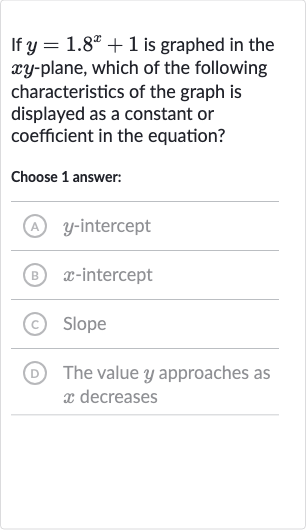AI tutor
Welcome to Bytelearn!
Let’s check out your problem:

If is graphed in the -plane, which of the following characteristics of the graph is displayed as a constant or coefficient in the equation?Choose answer:(A) -intercept(B) -intercept(C) Slope(D) The value approaches as decreases
Full solution
Q. If is graphed in the -plane, which of the following characteristics of the graph is displayed as a constant or coefficient in the equation?Choose answer:(A) -intercept(B) -intercept(C) Slope(D) The value approaches as decreases
- Identify constant term: Identify the constant term in the equation .The constant term in the equation is . This term does not depend on the value of and is added to the value of for all .
- Significance in graph: Determine the significance of the constant term in the context of the graph.The constant term in an exponential function like represents the vertical shift of the graph. In this case, the graph is shifted up by unit.
- Relate to characteristics: Relate the constant term to the characteristics of the graph provided in the choices.The constant term affects the -intercept of the graph. The -intercept is the point where the graph crosses the -axis, which occurs when . Plugging into the equation gives , which simplifies to , or . This shows that the -intercept of the graph is , and it is directly given by the constant term in the equation.
More problems from Dilations of functions
QuestionGet tutor help
QuestionGet tutor help
QuestionGet tutor help
QuestionGet tutor help
QuestionGet tutor help
